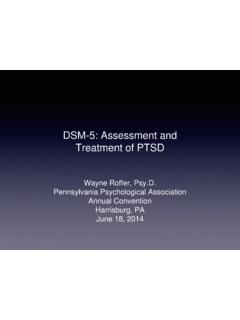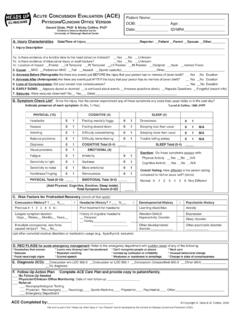Transcription of Communication Assessment for People with Behaviours of ...
1 Scope 2015 | (03) 9843 2000 | Communication Assessment for People with Behaviours of Concern - Literature review. Teresa Iacono & Nick Hagiliassis, 2010 Background Scope undertook an Office of the Senior Practitioner funded project in 2009 entitled Building the Foundations for Effective Communication for Victorians with Behaviours of Concern subject to Restrictive Practices . The project creates a mechanism for ensuring People with Behaviours of concern have access to appropriate, skilled support in areas where that support is currently inadequate. An objective of the project is to support skilled professionals (speech pathologists) in order that they may be able to undertake focussed Communication assessments for People with Behaviours of concern (BOC).
2 This will be achieved through compiling a list of assessments for evaluating Communication factors as they relate to BOC. Using this information, speech pathology professionals will have access to a summary of relevant Assessment tools, from which they can respond directly as well as build the capacity of Direct Support Workers in this area. It includes information about Communication Assessment tools and resources for: (1) Identifying the potential communicative functions of the Behaviours ; (2) Profiling the Communication abilities of the individual in order to inform appropriate Communication -based interventions; and (3) Observing current environmental barriers and identifying solutions. These aspects are assessed within a wider context captured within the Participation Model (Beukelman & Mirenda, 2005) whereby opportunities and access are assessed.
3 To inform the development of this Assessment list, a targeted literature review was undertaken. This literature review identified key Assessment instruments and procedures selected against a range of practice, access and psychometric criteria, which are described below. Notably, the review is not intended to be exhaustive. Identifying Specific Functions of Behaviours of Concern. Many functional behaviour assessments indicate whether BOC are serving functions that could be communicative, but may not always specify the exact communicative function. A completed Motivational Assessment Scale, for example, may indicate that the behaviour serves an escape function, but more information is needed to determine if the person uses Behaviours or other means to communicate a request to stop, to reject, or to request help.
4 Speech pathologists will need to either begin with Scope 2015 | (03) 9843 2000 | administering these broad functional assessments, or if one has been conducted ( , by a behaviour support team, a psychologist), access the results. These functional behaviour assessments should be followed by more specific functional Communication assessments. Profiling Communication Abilities The assessments have been included to enable identification of BOC and their functions, and then to profile the Communication skills of the individual to facilitate the development of appropriate positive behaviour supports. Such supports can include, but are not limited to, Functional Communication Training. Attempts to implement positive behaviour supports may be unsuccessful if the person s Communication skills are poorly understood.
5 As an example, a strategy that relies on a verbal explanation of rewards for a particular behaviour is likely to fail with an individual whose comprehension is limited to key words in a sentence, and who instead relies on environmental and social cues. For People who are non-speaking or have limited symbolic ability, a profile of cognitive skills ( , ability to understand cause-effect, to respond to familiar faces and events), as well as an understanding of the person s physical and social environment, and social-affective signalling may assist in developing social and physical environmental supports to reduce the potential for BOC and increase social interactions. Identification of the person s level of Communication is needed to tailor appropriate Communication supports and ability to benefit from various types of symbolic Communication (aided or unaided).
6 For People who comprehend and/or produce language, a profile is needed to determine exactly what level of linguistic input is understood, and to determine language production skills. In particular, there is a need to distinguish echolalia from productive language , a person who appears to have good language skills may in fact have poor underlying linguistic ability, but have the potential to benefit from aided or unaided Communication systems. This profiling of skills can assist in developing effective social and environmental supports. It also assists in identifying ASD. Criteria for Inclusion of Assessments These assessments are suitable for use by speech pathologists. They include both formal and informal measures that require skills in administration, scoring or recording of responses, and interpretation of results.
7 Some assessments involve obtaining information from paid or family carers. Consideration was given to the number of criteria met by each Assessment when deciding those to include. These criteria are outlined in Table 1. (next page) Scope 2015 | (03) 9843 2000 | Table 1: Criteria for inclusion of Assessments 1. Must provide information on one of the key areas identified as needed in conducting a Communication Assessment for People with BOC a. Identification of functions of any BOC. b. Profile of Communication I. Receptive skills II. Expressive skills, including symbolic ability III. Pragmatic skills (includes social interaction/ discourse, functional levels) c. Social and physical barriers and enablers I. Key individuals, their knowledge and attitudes II.
8 System supports III. Physical environment in light of physical, sensory and cognitive abilities. 2. Must be appropriate for one or more of the following groups a. Children or adults with developmental disabilities, including ID, autism, CP. b. Children or adults with acquired disability, including ABI, aphasia, degenerative neurological conditions. 3. Must be available for no or reasonable cost. 4. Must be easy to obtain ( , from a website or purchase within Australia). 5. Must be available to speech pathologists (eg, excluding tests that can be administered or purchased only by registered psychologists). 6. Must not require special training to administer by a speech pathologist (eg., requiring attendance at training course and receipt of a certificate).
9 Scope 2015 | (03) 9843 2000 | Assessments A summary of assessments is provided in Table 2. Table 2: Communication Assessment for People with Behaviours of Concern - Included Assessments Domain Assessment Population Identification of BOC 1. Overt Behaviour Scale (Kelly,Todd, Simpson, Kremer & Martin, 2006) Adults with Head Injury Functions of BOC 2. Motivation Assessment Scale (Durand, & Crimmins, 1992) Anyone demonstrating self-injurious Behaviours 3. Questions about Functional Behavior (Matson, & Vollmer, 1995). Anyone demonstrating BOC. Preferences 4. Affective Communication Assessment (Coupe, Barber & Murphy, 1988). Children with severe/profound ID, likely to be suitable for adults with severe/profound ID (Unintentional). 5. Triple C: Checklist of Communicative Competencies (Iacono, Bloomberg & West, 2005) Adults with severe and multiple disabilities (unintentional early symbolic).
10 Matrix (Rowland, 1996). Children at early stages of Communication . Cognitive and early Communication skills Temptations Children ( Fey, 1998; Paul, 2001). Children with pre-symbolic to early symbolic skills. 8. Modified Communicative Temptations children (Iacono, Carter & Hook, 1998) Children with multiple disabilities with pre-symbolic to early symbolic skills. Communication sampling (McLean, et al., 1991). Children or adults with developmental disabilities with unintentional to early symbolic skills Scope 2015 | (03) 9843 2000 | Functions of Echolalia Protocol (based on Prizant, & Duchan, 1981; Prizant, & Rydell, 1993). Anyone demonstrating echolalia, most relevant to adults or children with ASD 11. Communication Assessment Profile for People with Learning Disabilities (CASP) (van der Gaag, 2009).





